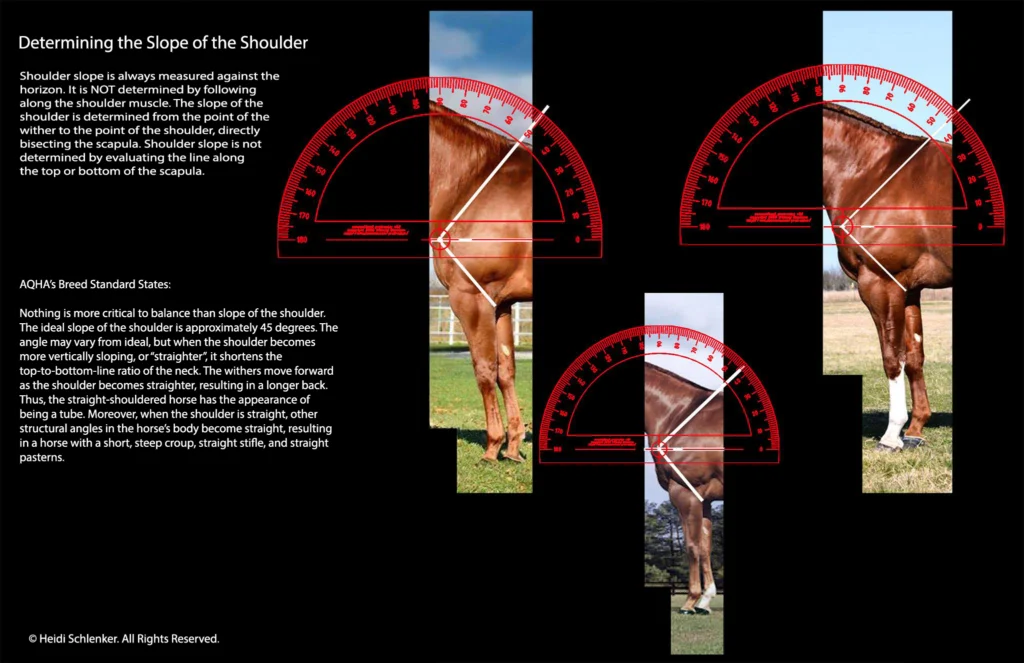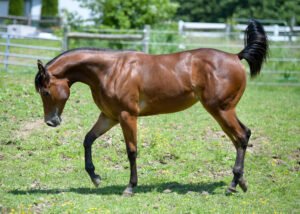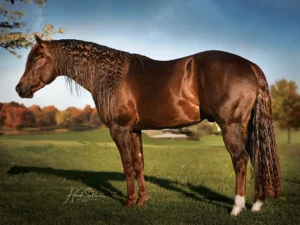Shoulder Slope in Horses: #1 Reason Your Horse Might Move Like A Dump Truck

Shoulder slope in horses is more than a visual detail—it’s the #1 structural element that determines balance, elevation, and long-term soundness.
🚨 We Need to Talk About Necks. And Shoulders. And Why Your Horse Moves Like a Dump Truck. 🚨
As the industry gets more obsessed with crossing papers to papers, and 💵 to 💵, conformation has somehow fallen to second… maybe third… hell, sometimes it’s not even on the list. And you know what we’re getting for it?
- 🐴 Straighter shoulders.
- 🐴 Lower neck tie-ins.
- 🐴 Shorter, thicker, tighter front ends.
…And a whole lot of navicular, kissing spine, “routine injections,” corrective shoeing, and front-end soft tissue injuries.
This is a public service announcement from someone who’s tired of watching trainers and horses suffer through biomechanics that never had a chance… but are still forced to perform.
Let me explain why this trend is literally forcing us to ride a downhill battle.
The Critical Role of Shoulder Slope in Horses
The shoulder is the most critical part of balance in a Quarter Horse. It dictates whether the front end can lift, rotate, and extend freely. A correct shoulder slope in horses (around 45° from horizontal—not to be confused with stacking bricks) gives the horse shock absorption, reach, and elevation. That scapula glides like butter.
But a steeper shoulder? That’s a one-way ticket to choppy strides, bracing, and a front end that lands like a sack of concrete. Your horse isn’t lazy. It’s biomechanically jammed.

How Shoulder Slope in Horses Affects Neck Tie-In
The slope of the shoulder directly determines where the neck ties into the body. With a correct slope, the scapula sits further back and lower, giving the neck room to tie in high, above the point of the shoulder. This allows for elevation, softness at the poll, and natural balance.
But that steep shoulder? Yeah. It shoves the neck tie-in down into the chest, compresses the entire front end, and gives you that glorious “low, thick, stuck” look we’ve somehow convinced ourselves is attractive because fluffy wants to pack his nose on the ground.
Low Neck Tie-In: A Recipe for Dysfunction
When the neck ties in low? Now your horse is dumping weight forward, struggling to lift its withers, traveling downhill, and relying on you and your trainer to ride every single stride to artificially lift the shoulders and back. (We’ve all seen those little raw spots on the belly from the constant lifting). Add in a thick throatlatch and zero flexion at the poll, and now your bridle is just decorative. Hope you like vet bills and mechanical training aids.
The Hidden Costs of Ignoring Shoulder Slope in Horses
The reality? The money is determined by an opinion on a certain day and soundness becomes an illusion… because it doesn’t show hard and stay sound and continue working hard into its twenties.
Training methods are more advanced than ever. Veterinary care is lightyears beyond what it was a decade ago. But are the horses really better? Or are we just spending more to mask conformational flaws that could’ve been avoided if we actually prioritized structure over status?
We aren’t evolving the breed—we’re enabling dysfunction with better band-aids and fancier marketing, and using purses as a means for determining worthiness of passing on genetics.
Functional Conformation Is Not Optional
Meanwhile, horses with a high neck tie-in and proper shoulder slope in horses move free. They elevate naturally. They don’t need crutches. They don’t need “routine hock injections at 3” or wedge shoes to survive. Their shoulders rotate, their necks break at the poll, and they carry themselves with ease because they’re built to.
- 💥 Reiners need that lift for stops and rollbacks.
- 💥 Ranch riders need it for softness and transitions.
- 💥 Cow horses need rapid shoulder control.
- 💥 Western riding needs natural elevation for lead changes and cadence.
This isn’t nitpicking—it’s shoulder slope in horses and its functional consequences. And it’s disappearing fast in favor of a look that’s killing our horses one injection at a time.
Conclusion: Fix the Foundation
So no, that super low neck tie-in isn’t “pretty.” It’s why his hocks need tapped at 3, his front feet are falling apart, and your trainer is sweating more than the horse.
Conformation isn’t optional. It’s the foundation. And it starts at the shoulder—and shows in the neck.
📌 Save this. Share it. And next time someone brags about their horse’s “pretty low neck,” ask them how often their horse sees the vet.
Explore more performance conformation blogs
FAQs: Shoulder Slope in Horses
1. Why does a steep shoulder slope limit movement?
It restricts scapular rotation, causing short, choppy strides and reducing front-end shock absorption.
2. How does neck tie-in relate to balance?
A high tie-in supports natural balance and elevation. A low tie-in encourages forward weight dump and bracing.
3. Is a low neck tie-in ever functional?
Yes. Downhill conformation is beneficial to flat racers. It allows the horse to get lower to the ground, while propelling with the hindquarters. Racing is what the Quarter Horse was bred to do. However, as the breed has evolved, we ask these horses to do a variety of specialized events, and while speed is important for some of these events, many events require maneuvers that require elevation and drive.
4. Can training overcome poor conformation?
To an extent. But you’ll rely on mechanical aids and see long-term physical issues.
5. What should breeders prioritize?
Structure over status. Sound, functional conformation creates horses that last and perform naturally.




Leave a Reply